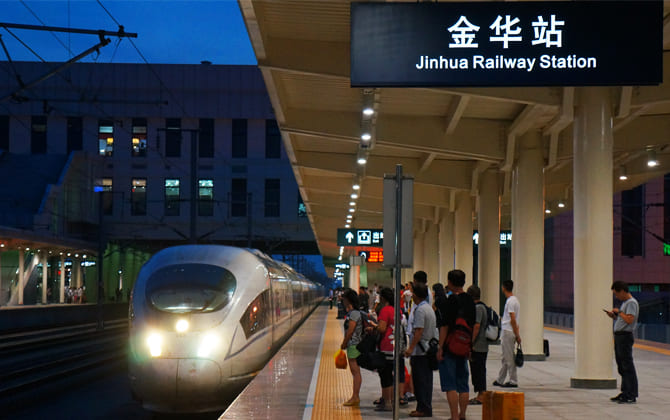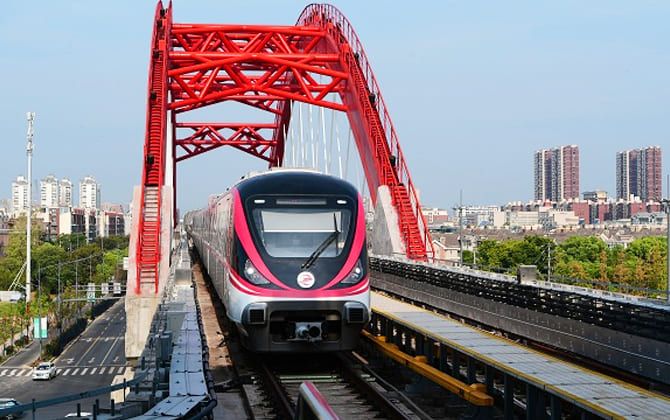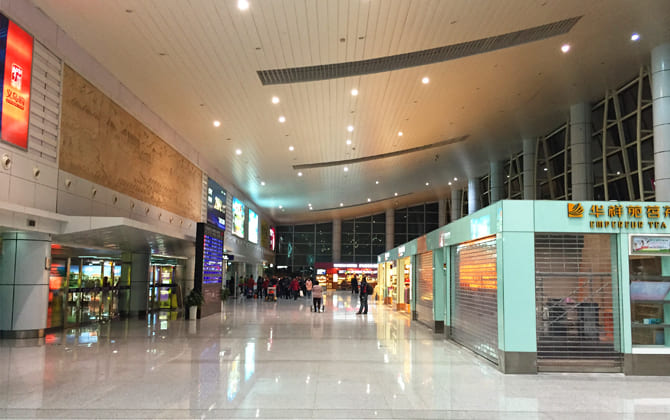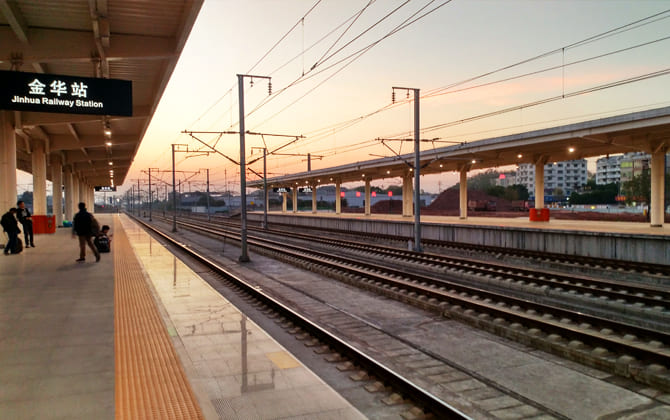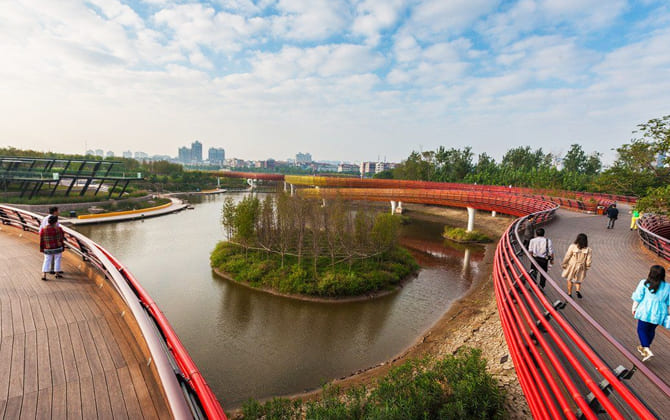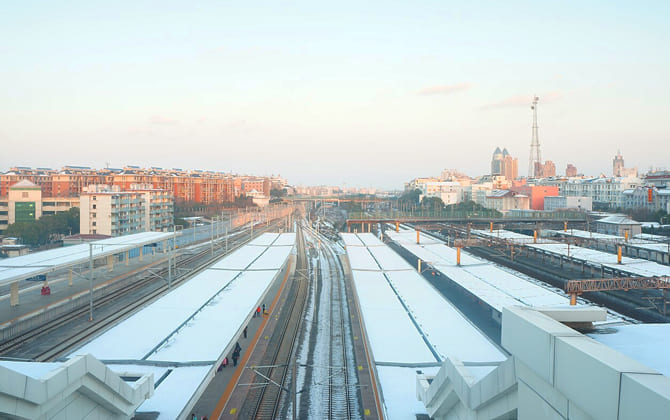Jinhua Rail Transit is a suburban rapid transit system serving the city of Jinhua in central Zhejiang Province, China. Opened in late 2022, it connects Jinhua with Yiwu and Dongyang, forming a T-shaped network over 107 km (66 mi).
The system now has two lines (launched in 2022–2023) with more than 30 stations. Trains reach speeds of up to 120 km/h (75 mph), making travel between the cities much faster than by car. Jinhua Rail Transit is operated by the Jinhua Rail Transit Group and links with the national railway at several hubs, including Jinhua and Yiwu, strengthening regional connections.
The network is often called the “Jinyidong Line,” referring to its route between Jinhua, Yiwu, and Dongyang. It runs mostly on elevated viaducts, with some underground parts. Construction began in 2017 and finished in 2022. Engineers used advanced methods, such as tunneling and long-span bridges, to cross three rivers and two mountain areas. The project cost about ¥34.6 billion (≈$5 billion).
Since opening, Jinhua Rail Transit has become a key part of public transport in the Jinhua–Yiwu area. In 2023, it carried around 37 million passengers.
Jinhua Rail Transit Map 2026
The Jinhua Rail Transit map (2026) includes Line 1 (Jinhua–Yiwu, known as the Jinyi line) and Line 2 (Yiwu–Dongyang, known as the Yidong line). The two lines meet at Qintang Station in Yiwu, making transfers simple. Together they form a continuous corridor from Jinhua Railway Station in the west to Ming & Qing Dynasty Palaces Station in Hengdian, Dongyang, in the east.
Network statistics: total length about 107 km (66 mi), extended to around 118 km (73 mi) after full opening; 32 stations built (31 in service, 1 not yet open); and end-to-end travel time around 1.5 hours on local trains. The system is designed for through-running between the two lines via Qintang, creating a single long corridor. In practice, until every segment and station is complete, trains may still run in two separate sections.
Jinhua Rail Transit showing different lines. Click on the map to enlarge it or download the Jinhua Rail Transit map in PDF format.
Jinhua Rail Transit Lines & Complete Stations List
Jinhua’s rail transit now includes two lines, with the complete station list below. Stations marked with “★” are major interchange.
Jinyi Line (Line 1 – Jinhua to Yiwu): Jinhua Railway Station★, West Shuangxi Road, South Bayi Street, Wanda Plaza, Dayanhe Street, Railway Building, Jinhua South Railway Station★, Tangya, Comprehensive Bonded Zone, Xinqu (New District), Donghua Street, Yiting, Guantang, Choujiang, Xiuhu, Qintang★. Length: 58.4 km (36.3 mi); 16 stations; opened August 30, 2022. This line starts at Jinhua Railway Station downtown and runs east through the city and suburbs before ending in Yiwu at Qintang.
Yidong Line (Line 2 – Yiwu to Dongyang): (Yiwu Railway Station) (planned), Lingyun★, Chunhan, Qintang★, International Trade Center, Fourth Affiliated Hospital (Zhejiang Univ.), Jiangdong, Woodcarvings City, Geshan Road, Renmin Road, Conference & Exhibition Center, Sports Center, Hengdian Railway Station★, Ming & Qing Dynasty Palaces★. Length: 48.8 km (30.3 mi); 13 stations open (15 planned); opened in phases from December 28, 2022 to April 2023. The line will eventually begin at Yiwu Railway Station and head south to Dongyang’s Hengdian area. Qintang serves as the main transfer point with the Jinyi line, with cross-platform transfers on the same level.
Note: As of 2026, Yiwu Railway Station on the Yidong line is still under construction as part of the national rail expansion. Trains now start and end at Lingyun. Hengdian High-Speed Station opened for metro service on September 6, 2024, and will connect to a future high-speed rail. When all stations are active, the combined Jinyi–Yidong corridor will include 32 stations between Jinhua and Dongyang.
Stations are modern and designed to reflect local culture. For example, Woodcarvings City Station features Dongyang’s woodcarving tradition. Key hubs include Jinhua Railway Station (with national rail and bus links) and Yiwu International Trade Center Station (near the wholesale markets). At Qintang, the twin-island platform layout allows smooth cross-platform transfers between the two lines.
Jinhua Rail Transit Train Schedule & Operating Hours
High-Speed Train Schedule
Besides the metro, Jinhua Railway Station is a key hub on China’s high-speed rail network. Dozens of G/D/C trains depart daily, linking Jinhua with major cities nationwide.
- Shanghai: ~65 trains per day, 06:28–21:47. Fastest trip ~1 h 31 min, longest ~3.5 h. Second-class fare ¥93 (~$13).
- Hangzhou: 110+ daily trains, 06:28–22:24. Fastest trip ~38 min. Fare ¥52 (~$7) second class.
- Beijing: ~5 direct trains daily, 5.3–7.7 h. Second-class fare ¥679 (~$95).
- Guangzhou: ~5 trains daily, 5–6.5 h. Fare ¥720 (~$101).
- Nanjing: ~32 trains per day, 1.8–4.7 h travel.
- Chengdu/Chongqing: Long-distance G-trains, 9–11 h to Chengdu, 9–10 h to Chongqing.
- Wuhan & Zhengzhou: Several daily trains, 4–8 h travel time.
- Xi’an: 2 daily trains, 9–11 h.
- Kunming: 6 daily trains, fastest trip ~6 h.
- Xiamen: ~11 trains, 3.5–4.8 h.
Regional: Frequent short hops: Yiwu (~25–30 min, ¥14 / ~$2; 7–9 trains daily), Wenzhou (~42 daily, 1.2–1.8 h), plus links to Jinan, Tianjin, Guilin, Changsha, and more. Almost all major cities are reachable with one transfer.
High-speed trains depart mainly from Jinhua’s North Station Hall. The first train leaves at 06:28, last arrivals are around 22:30. Schedules change seasonally—always confirm via the official 12306 app or at the station.
Normal-Speed Train Schedule
Conventional trains (T, K, Z series) also serve Jinhua, often as budget or overnight options. They are slower but cover many destinations, usually with sleeper cars.
Beijing / Shanghai / Guangzhou: Overnight trains link Jinhua with Beijing (~21–22 h), Shanghai (~5–6 h by K-train), and Guangzhou (~13–18 h). Example: T211 to Shenzhen departs ~14:50, arrives ~15 h later.
Provincial Capitals: Direct trains to Changsha, Chengdu (~26–30 h), Chongqing, Nanjing, Wuhan, Xi’an (~23 h), Hefei, Jinan, and others.
Regional Lines: Many K-trains to Hangzhou and Ningbo (1–4 h, dozens daily), Wenzhou (~14 trains, 4–7 h), Xuzhou, Qingdao (12–25 h). Nearly 40 daily slow trains run to Hangzhou due to proximity.
Within Zhejiang: Jinhua is on the Shanghai–Kunming line, so all westbound K/Z trains pass through. Yiwu is 30–60 min away, with ~27 daily trains between Jinhua and Yiwu.
Conventional trains are cheaper. For example, Jinhua–Beijing hard sleeper costs ~¥351 (~$49). Options include hard and soft sleeper berths for overnight comfort. These trains depart from Jinhua Station’s South Station Hall. Overnight trips are a practical choice for saving a hotel night. Always check updated schedules.
Operating Hours, Opening & Closing Times
Jinhua Rail Transit runs daily from about 06:00 to 22:00. First trains depart around 06:30 from terminus stations. After the 2024 schedule extension, the last train from Jinhua Station leaves around 21:20, and the last from Qintang at 22:00, giving about 16.6 hours of service per day. Officially, trains operate from 06:00 to 21:55, with 10-minute intervals during most of the day. Stations usually close shortly after 22:00.
Example: At Jinhua Station the first train is at 06:30, last at ~21:20. From Dongyang (Ming & Qing Palaces) the last return departs ~21:00–22:00. At central stations like Qintang, the last departures are slightly later (~22:00).
National railway hours: Jinhua’s main station opens before the first departures around 05:00–06:00 and stays open until the final arrivals near midnight. Ticketing halls generally run 07:00–23:00, while overnight waiting rooms may stay open for late trains. Jinhua South Railway Station follows similar hours, closing after the last high-speed train near 23:00. Always confirm if traveling very early or late.
Jinhua Rail Transit Ticket Prices & Fare 2026
Jinhua Rail Transit uses a distance-based fare system designed to keep travel affordable and encourage daily use.
Base fare: ¥2 (~$0.28) for the first 8 km (5 mi). This 8 km threshold is the longest ¥2 base distance in China, making short trips cheaper than in most cities.
Incremental fares:
- 8–28 km (5–17 mi): ¥1 (~$0.14) per 4 km (2.5 mi)
- 28–64 km (17–40 mi): ¥1 per 6 km (3.7 mi)
- Beyond 64 km (40 mi): ¥1 per 8 km (5 mi)
Examples: A 5 km (3 mi) trip costs ¥2. A 20 km (12 mi) ride costs ¥5. The full Jinhua–Yiwu trip (~58 km / 36 mi) is ¥12 (~$1.70). Traveling the entire line from Jinhua to Dongyang (~106 km / 66 mi) is about ¥18–20 (~$2.50–2.75). These fares are heavily subsidized to support the “1-hour travel circle” in the region.
Children & concessions: Seniors, students, and disabled passengers receive discounts or free rides under official policies. Children under 1.2 m (3.9 ft) ride free with an adult. Many older adults and disabled veterans travel at half price or free.
Ticket types: Single-ride tokens (plastic coins) are sold at machines and ticket windows. Riders tap to enter and deposit tokens on exit. Frequent travelers can use the Jinhua Transit IC Card (Jinhua Tong), a stored-value smart card also valid on city buses. Mobile payment is supported: Alipay, WeChat Pay, UnionPay QuickPass, and QR codes in the transit app work at gates.
Day Pass: Riders pay per trip, but the low fares keep costs down even with multiple rides (e.g. four short 5 km trips total ¥8 / ~$1.10). For convenience, frequent riders are advised to use the IC card or mobile apps instead of buying cash tickets each time.
Routes and Connections & Railway to Airport
Buses: Jinhua Rail Transit is closely linked with the city bus network. Most stations have bus stops or hubs nearby. Jinhua Railway Station, for example, is surrounded by four bus stops serving many routes, including lines 11, 15, 18, 24, 27, 330, B3, and B4. In Yiwu and Dongyang, stations such as International Trade Center, Jiangdong, and Sports Center are all served by multiple bus routes. Qintang Station connects with buses into Yiwu’s downtown and market areas. In Hengdian, stations connect with shuttle buses to tourist attractions—Hengdian Studios even runs free shuttles from Ming & Qing Palaces Station directly to its park gates.
Railway to Airport: Jinhua has no major airport. The nearest is Yiwu Airport (YIW), about 50 km (31 mi) northeast. There is no direct rail connection, but travelers can take a high-speed train from Jinhua to Yiwu (20–30 minutes), then a taxi or airport shuttle for the remaining 20 km (12 mi). Direct long-distance buses also run from Jinhua to Yiwu Airport (~1 hour).
Another option is Hangzhou Xiaoshan International Airport, about 140 km (87 mi) north. From Jinhua, passengers can take a high-speed train to Hangzhou East (40–60 minutes) and then transfer by airport bus or Metro Line 1.
Facilities & Passenger Services
Stations are equipped with standard metro facilities: elevators, escalators, electronic displays, bilingual announcements, and platform screen doors in new underground stops. Major stations also have customer service centers for ticketing and tourism help. Some stations offer rest areas, kiosks, and public restrooms, reflecting the longer distances this system covers compared to typical urban metros.
One special feature is Jin-Gui Kuaiyun, a rail express courier service. Certain trains and stations can carry small parcels, enabling same-day delivery between Jinhua, Yiwu, and Dongyang.
In June 2026, the system hosted its first “Pet-Friendly Special Train.” Dozens of pet owners traveled with their dogs on a themed train from Jinhua to Hengdian for a pet expo. The event, with a “Cute Pets” design, showed the system’s ability to run special chartered trains for tourism and events without affecting regular service.
Parking Charges per Day at Stations
Parking is available at major stations such as Jinhua Railway Station, Jinhua South, and several suburban stops like Dongyang Sports Center. At Jinhua Railway Station, large parking lots are located on both the North and South squares. Fees are ¥5 (~$0.70) for the first hour, then ¥3 (~$0.40) per half-hour from 08:00–22:00, capped at ¥50 (~$6.80) per day. Overnight parking (22:00–08:00) is a flat ¥5. A full 24-hour stay costs up to ¥55 (~$7.50).
Jinhua South Railway Station uses similar pricing, with daily maximums around ¥50–¥60 (~$6.80–$8.20). Some suburban stations (Tangya, Yiting, Hengdian) have park-and-ride lots. During trial operations, parking was free, but since 2026, Dongyang section stations introduced small fees. For example, Dongyang Sports Center Station now charges a few yuan per hour. The city is adding smart parking systems and more spaces near stations to support park-and-ride travel.
Many hotels near stations, especially around Jinhua Station, offer free parking for guests. This is useful during holidays when station lots fill quickly. On weekdays, arrive early if you plan to park, as demand is high.
How to Get to Jinhua Railway Station
Jinhua Railway Station is centrally located, about 5 km (3 mi) from the city center. It is accessible by metro, bus, taxi, walking, or bike.
By Metro: Take the Jinyi Line to its western terminus, Jinhua Railway Station. The metro connects directly to the departures hall. For example, from Bayi South Street, it’s just 2 stops.
By Bus: Over 20 bus routes stop at the station:
- North Square: lines 809/K809, B3A, B3-B, B4
- Nearby stop: lines 11/K11, 18, 27/K27, 303, 305, 330, Tour 3 (Y3)
- South Square: lines 15/K15, 18, 304, 317, 318, 319, 339, 350, 528, 808
For example, Tour 3 (Y3) is a loop line linking the station with attractions like Double Dragon Cave.
By Taxi/Ride-hailing: A ride from downtown (People’s Square) takes 10–15 minutes for 5 km (3 mi). The fare is ¥10–¥15 (~$1.40–$2). Apps like DiDi can be set to “Jinhua Railway Station (North/South).” Traffic can be heavy at rush hours.
On Foot/Bike: From downtown, the station is a 30–40 minute walk. Shared bikes are common and take 15–20 minutes. Bike racks are available at entrances.
The station has two main entrances: North Building (high-speed trains) and South Building (conventional trains). Both are connected inside, so you can enter from either. Metro exits lead directly to the concourse.
How to Get to Jinhua South Railway Station from Jinhua Railway Station
Jinhua South Railway Station is the city’s high-speed hub about 10 km (6 mi) south of the main station.
By Metro: Take the Jinyi Line from Jinhua Railway Station to Jinhua South (often labeled “Jinhuanan”). About 6 stops, 15–20 minutes, trains every ~10 minutes. Fare ~¥3 (~$0.42).
By Bus: City Bus 24/K24 runs directly between the two stations. About 30 minutes in normal traffic. Fare ~¥2 (~$0.28). Board at the stop in front of the main (South) station entrance.
By Taxi: ¥30–¥40 (~$4.20–$5.60), 25–30 minutes depending on traffic. Handy with luggage or if you’ve just missed a bus/metro.
Both stations have clear bilingual signs. When returning by metro, check train direction (the line continues beyond Jinhua South). Station staff will help—show your rail ticket if needed.
How to Get to Famous Scenic Spots from Railway Station
- Double Dragon Scenic Area (Shuanglong Caves): Tourist Bus Y3 (Tour 3) departs from Jinhua Railway Station; about 1.5 hours through mountain roads, fare ¥3 (~$0.42). Taxi is faster—~30 minutes, ¥40–¥50 (~$5.60–$7.00).
- Duke Shi’s Palace of the Taiping Heavenly Kingdom: In downtown Jinhua. From the station, take bus 809/K809 to “Municipal Museum,” then walk ~300 m (0.2 mi). Bus fare ~¥2 (~$0.28), total ~40 minutes. Taxi: 4–5 km (2.5–3.1 mi), ~15 minutes, ~¥10 (~$1.40).
- Hengdian World Studios (Dongyang): Take Jinhua Rail Transit from Jinhua Railway Station to “Ming & Qing Dynasty Palaces” in Hengdian. ~106 km (66 mi). Express services (when available) ~1 hour; all-stops ~2 hours. Fare ~¥18 (~$2.50). Free studio shuttles connect to other sets (Qin Imperial Palace, Dream Valley, etc.).
- Jinhua City Museum & Architecture Park: Near the center, ~3–4 km (1.9–2.5 mi) from the station. Buses to People’s Square/Municipal Government (e.g., 15 or 19 for the museum), or a short taxi ride ¥8–¥10 (~$1.10–$1.40).
- Yiwu International Trade Market: From Jinhua Railway Station, take a high-speed train to Yiwu (~25 minutes) or ride the metro to International Trade Center Station (~1+ hour). Many business travelers choose the day trip instead of staying overnight.
Interesting Facts & History
Recent Launch: Jinhua Rail Transit is one of China’s newest metro systems. Trial service on the Jinyi section began August 30, 2022, with full operations by mid-2023. Few cities launch with such long routes—Jinhua started with 107 km (66 mi), while most cities begin with shorter starter lines.
Construction Timeline: Groundbreaking took place on July 28, 2017. In only five years, the system went from planning to operation. A 1 km (0.6 mi) test segment was even started in December 2016 to trial construction methods. By September 2021, all Jinyi tunnels were finished. Despite pandemic-related suspensions in 2022, the project remained on schedule.
Record Length: The initial Jinyidong Line, at ~107 km (66 mi), ranks among the world’s longest metro lines opened in one go. It links three municipalities—Jinhua, Yiwu, and Dongyang—making it China’s first intercity metro outside major metro areas. Officially, it is classified as an urban-suburban railway (“市域铁路”), blending metro and commuter rail features.
Technology: The line uses 1500 V DC third-rail electrification, rare for such a long route. Trains are custom 6-car “B-type” sets with narrower bodies, fast acceleration, and top speeds of 120 km/h (75 mph). Despite the long distances, the cars feature open gangways and longitudinal seating for higher capacity.
Express Services: Express trains (“大站快车”) run during peak hours, skipping stops and cutting Jinhua–Qintang travel from 55 minutes to just 31. Two pairs of express trains operate daily, one in each direction during morning and evening peaks.
Cross-Platform Interchange: At Qintang Station in Yiwu, a double-island platform allows passengers to switch between the Jinyi and Yidong lines simply by crossing the platform—an uncommon but very efficient design.
Ridership: In 2023, the first full year of service, ridership reached 37 million—over 100,000 daily trips on average. Numbers are expected to grow as commuting between Jinhua and Yiwu increases and Hengdian tourism expands.
Name and Branding: Locally the system is called “金义东市域轨道” (Jin-Yi-Dong Rail), after the three areas it serves. The official logo features a stylized “JRT” in red. Yiwu and Dongyang stations showcase local culture, such as film set replicas at Ming & Qing Palaces Station in honor of Hengdian’s movie studios.
Pet Train: On June 22, 2026, the system ran a one-off “Pet Special Train.” More than 50 owners and 30+ dogs rode from Jinhua to Hengdian for a pet expo. The event, widely covered in media, highlighted Jinhua Transit’s innovative and tourist-friendly approach.
Historical Context: Jinhua has long been a rail hub, sitting on the Zhejiang–Jiangxi Railway. The new urban rail network is part of the “Central Zhejiang Urban Cluster” plan, integrating Jinhua, Yiwu, and surrounding cities into one metropolitan region. A 15-year plan announced in 2017 outlined four lines; the Jinyidong Line is its first major milestone.
Future Expansions & Upcoming Lines
The growth of Jinhua Rail Transit is only beginning. City planners are working on Phase 2 and Phase 3 projects, aiming for a complete network by 2035.
Jinwuyong Line (Line 3, planned): This line will connect Jinhua, Wuyi, and Yongkang, with a possible extension to Dongyang to form a loop. Planned length is about 111.7 km (69 mi) with 26 stations. It will run from Luodian (Jinhua) through Wuyi County and Yongkang City, ending at Hengdian (Dongyang), where it will link with Line 2. This line would connect key county-level cities not yet served by rail. As of 2026, it is still in the planning and approval stage.
Dongyi-Pu Line extension (Line 2 north): The Yidong Line (Line 2) is the first section of a longer Dong-Yi-Pu corridor. It will extend north from Yiwu to Pujiang (about 20 km / 12 mi). This extension would connect with the planned Jinhua–Hangzhou Intercity Railway and potentially serve Yiwu Airport, creating a direct airport link. Construction is expected after 2026.
Jinyi Line Phase 2 (Line 1 extension): The Jinyi Line currently ends at Jinhua Railway Station. A westward extension to Lanxi City (~39.7 km / 24.7 mi, 12 stations) is planned. This “Jin-Lan Line” (sometimes called Line 4) would connect Lanxi with downtown Jinhua and link at Jinhua West and Jinhua Railway stations. It is scheduled for the 2030s.
Urban infill lines: As Jinhua’s population grows, shorter city-only metro routes may be added in the 2030s. These could include loops or cross-city lines to serve districts not on current intercity routes.
Integration with regional rail: Jinhua is part of the Yangtze River Delta transport network. New lines such as the Jinhua–Jiande Railway and Hangzhou–Wenzhou High-Speed Railway (via Yiwu and Dongyang, due by late 2026) will add new interchanges. Hengdian HSR Station opened in September 2024 as a metro stop. Tangya Station on Line 1 was designed for future transfer to the Hangzhou–Jinhua Intercity line. A future airport link is also under discussion.
Expansion timeline: By 2030, the current network is expected to include extensions to Pujiang and Lanxi. By 2035, up to 4 lines totaling ~265 km (165 mi) and 78 stations may be in service. This would put over 90% of Jinhua’s population within 10 km (6 mi) of a rail station. The only exception would be remote Pan’an County.
All expansions aim to strengthen the “Central Zhejiang Urban Cluster,” ensuring Jinhua, Yiwu, Dongyang, Yongkang, and Lanxi residents can travel between city centers within an hour. The opening of the Jinyidong Line was just the first step. New sections, such as the Pujiang extension, may start construction soon, bringing Jinhua’s metro into a new phase of regional connectivity.

